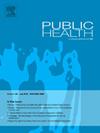为在感染高致病性禽流感的处所工作的人士提供公共卫生建议。
IF 3.2
3区 医学
Q1 PUBLIC, ENVIRONMENTAL & OCCUPATIONAL HEALTH
引用次数: 0
摘要
目的:采取保护措施防止禽流感(AI)的鸟对人传播(正确使用个人防护装备[PPE],如果建议服用抗病毒药物)和增加对人类AI的及时发现(接触后及时报告症状)是不完善的。该项目的目的是与在受感染场所工作的人共同为人工智能提供公共卫生建议。研究设计:联合生产,遵循敏捷联合生产和评估(ACE)框架,用于开发消息传递和指导。方法:我们共同制作了五份简单的英语简报(1)。2.禽流感;PPE, 3。达菲®(奥司他韦),4a级。报告症状和积极随访,4b。报告症状和被动随访),并附有基于理论、既往文献、行为科学原则和利益相关者意见的信息图表。包括两名不会说英语的人在内的17名在受感染场所工作的人对表格进行了反馈,并分享了他们在受感染场所工作的生活经历。结果:联合生产者通常更喜欢信息图表,而不是情况说明书,并建议如何在农场展示和在家禽养殖社区传播情况说明书。建议的修改包括缩短短语,修改语言和图像以与现场使用的术语和项目保持一致,如果不理解随附的文本,信息图表中的图像有时会含糊不清。联合制片人还建议制作视频来搭配这些床单。结论:合作制作过程有助于与在受感染场所工作的人建立良好的工作关系,并对他们的经历提供了实际的见解。本文章由计算机程序翻译,如有差异,请以英文原文为准。
Co-producing public health advice for people working on premises infected with highly pathogenic avian influenza
Objectives
Uptake of protective measures to prevent bird-to-human transmission of avian influenza (AI) (correct use of personal protective equipment [PPE], taking antivirals if recommended) and to increase the timely detection of AI in humans (prompt reporting of symptoms after exposure) is imperfect. The aim of this project was to co-produce public health advice for AI with people who work on infected premises.
Study design
Co-production following the Agile Co-production and Evaluation (ACE) framework for developing messaging and guidance.
Methods
We co-produced five factsheets in simple English (1. avian influenza, 2. PPE, 3. Tamiflu® (oseltamivir), 4a. Reporting symptoms and active follow-up, 4b. Reporting symptoms and passive follow-up), with accompanying infographics based on theory, previous literature, behavioural science principles, and stakeholder input. Seventeen people who worked on infected premises including two people who did not speak English gave feedback on sheets and shared their lived experience of working on infected premises.
Results
Co-producers generally preferred infographics to factsheets and suggested how sheets could be displayed on farms and disseminated within the poultry farming community. Suggested changes included that phrases should be shortened, amendments made to language and images to align with terms and items used on site, and that images in infographics were sometimes ambiguous if accompanying text was not understood. Co-producers also suggested creating videos to accompany the sheets.
Conclusions
The co-production process helped to develop good working relationships with people who work on infected premises and gave practical insight into their experiences.
求助全文
通过发布文献求助,成功后即可免费获取论文全文。
去求助
来源期刊

Public Health
医学-公共卫生、环境卫生与职业卫生
CiteScore
7.60
自引率
0.00%
发文量
280
审稿时长
37 days
期刊介绍:
Public Health is an international, multidisciplinary peer-reviewed journal. It publishes original papers, reviews and short reports on all aspects of the science, philosophy, and practice of public health.
 求助内容:
求助内容: 应助结果提醒方式:
应助结果提醒方式:


